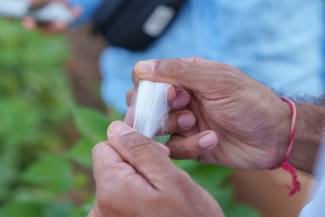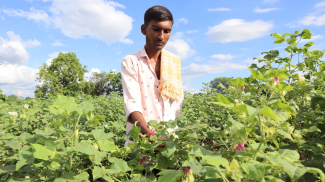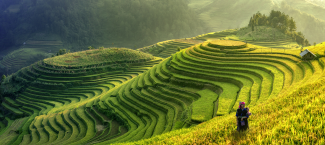Cotton in-conversion Project India
ALDI supports cotton farmers in India move
from conventional to organic farming.

India is the world’s biggest producer of cotton accounting for about 23% of the global cotton production, according to ICAC - the International Cotton Adivsory Committee. However, conventional cotton farming is related to a range of environmental risks.
One way to reduce negative impacts is to move from conventional to organic farming. The use of organic agricultural practices reduces negative impacts on the wider environment, including those related to soil health, water quality and biodiversity, it also improves the livelihoods of farmers and positively impacts the health of local communities.
ALDI wanted to be part of the solution, this is why it has launched the Cotton in-conversion to organic project.

In 2022, the ALDI SOUTH Group and ALDI Nord Group together with the Deutsche Gesellschaft für Internationale Zusammenarbeit (GIZ) GmbH, on behalf of the German Federal Ministry for Economic Cooperation and Development (BMZ), launched a project in India that supports approximately 1,000 smallholder farmers to move from conventional to organic cotton farming.
Currently organic cotton only accounts for approximately 1% of the global cotton market. Our long-term goal is to start to increase the availability of organic cotton.
Transition from conventional to organic farming
The transition from conventional to organic cotton farming takes up to three years. This means that farmers only receive a higher price for their cotton once it is certified organic in the fourth year. This three-year transition is a major barrier for many smallholder farmers because during this time they will experience yield loss and higher production costs.
ALDI supports these smallholder farmers during the transition period with training on agricultural practices, natural fertiliser, organic pesticides, soil fertility as well as provision of high-quality organic seeds. These activities are provided by implementation partners on the ground.

ALDI products
It is not enough that we just support the farmers through this project, we also have an obligation to support the demand for in-conversion to organic cotton by selling products made from it.
We are pleased to be able to provide our customers with a number of different styles of cozy family pyjamas, which are made from the project’s cotton and will be available in several markets across Europe by the end of February 2023.
The cotton from this project is processed in Bangladesh and is used for our own products. Another fact is that transportation is approximately 3% of emissions within the apparel industry (Source: McKinsey).

Field trip
In November 2022, our International Corporate Responsibility (CR) Team and the implementation partners directly met the smallholder farmers from the project. During the meetings, smallholder farmers shared with us what benefits they have noticed as well as what they found challenging. Some farmers observed better health conditions through not applying pesticides anymore, but many farmers also highlighted the yield loss they experienced from the transition.
During our exchange with the organisations supporting the project it became clear how important access to high-quality seeds is and also training in successfully handling pest control in a natural way.
Cotton Production
After sowing the plant, it takes 4-7 months until the cotton can be harvested. The cotton plant develops through five stages before the cotton ball is ready for picking. After the harvest, the seed cotton is put into a gin where the cotton lint is mechanically separated from the seeds and plant rests. After ginning, the cotton fibres (lint) are pressed in bales and transported to the spinning mill, where the cotton is blended, cleaned, carded, combed, and spun into yarn. The cotton yarns are then used for weaving or knitting of fabrics, dyed, and printed and garmented into the final textile product.








